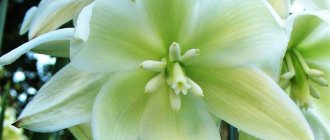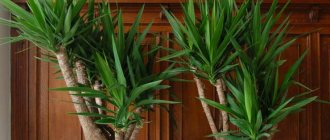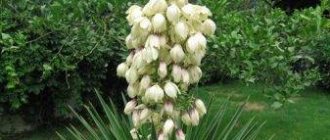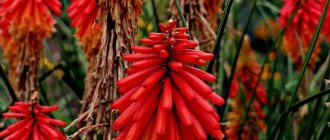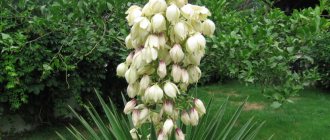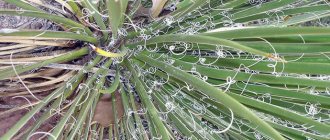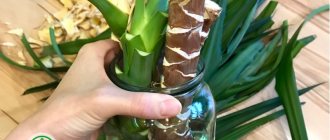The plant, which naturally occurs in the subtropical and tropical zones of the American continent, despite its exotic appearance, turned out to be not so capricious. Accustomed to the arid semi-desert climate with sharp temperature changes, yuccas were able to acclimatize even in the middle zone. True, bearing only minor frosts in the open ground, plants need good shelter for the winter. And in the southern regions of the country they are often grown without any restrictions. Two types are suitable for planting and caring for yucca in open ground. They are Yucca filamentosa, so named because of the long fibers that hang from the edges of the tough foliage, and Yucca gloriousa. The first type predominates in Russian plantings because it is more winter hardy.
A large evergreen plant is easily recognized by its pointed, lanceolate leaves that form a dense rosette. With a width of 3–6 cm, the length of one leaf blade can reach 50–70 cm. As they grow, the lower rows of leaves wither, and when they dry out, they droop, forming a kind of skirt around the trunk. If garden yucca is in good conditions, does not freeze or suffer from waterlogging, it blooms every year. The flower stalks, up to 1.5–2 meters thick, cannot be overlooked. And when from 80 to 150 white, yellowish or pink bells with a diameter of up to 6 cm open on them, the appearance of yucca amazes the imagination of any gardener.
Why is pruning needed?
Pruning allows you to give the flower a beautiful shape. A young plant looks good in a pot, but as it grows, it stretches out and lacks splendor: the trunk is thin, there are few green leaves. Therefore, the top is cut off and the branching process is started in a similar way. The crown becomes richer, and the flower itself looks more alive.
Yucca grows quickly; at home, the root system cannot always provide the crown with moisture and nutrients - when the stem is shortened, this problem disappears.
If the plant begins to die, then pruning is also carried out. This is how cuttings are obtained from which new specimens will grow. If the trunk has rotted, it is often possible to save the tops, which are used for further rooting.
Another reason for pruning is trunk curvature. A bent stem can break, which is very painful for yucca. In addition, there is a risk that the pot will simply fall under the weight of the leaves. Therefore, it is better to cut off the crooked trunk and allow the flower to grow new shoots.
The plant is also pruned if it is damaged by a pest or fungus. More often this happens with yucca growing in open ground. In order to save the flower, all its damaged parts are removed and the plant is treated with chemicals. Leaves that have been cut are immediately disposed of so that the pest does not spread throughout the garden.
Selection of location and conditions of detention
Yucca is one of the most unpretentious garden plants. It is able to bloom and bear fruit in drought and frost. To achieve abundant flowering, active growth and rich color, it is extremely important to comply with planting conditions and proper care. Below we will look at the key points of growing outdoor yucca.
Lighting and location
Yucca, like other members of the family, prefers well-lit places, but can also bloom in partial shade, especially when planted in sunny regions. Lack of light negatively affects the condition of the leaves - they stretch upward strongly, and the structure of the leaf plate changes.
In variegated yucca species, if there is insufficient lighting, the leaves may begin to turn pale and the rosettes may loosen. In addition, protection from the wind is required, since this is a tall plant that can break in strong gusts.
There are no soil requirements for planting; yucca is unpretentious to the quality and composition of the soil, but when planted in acidic substrates, the quality of flowering deteriorates. Before planting, it is advisable to add organic matter, to which the plant responds well. If there is a lack of minerals in the soil, flowering may be delayed for several years.
Temperature
Like other exotic plants, yucca feels best at stable warm air temperatures (15-22°C). However, most varieties of the plant can easily tolerate extreme heat and cold. Before planting, it is advisable to wait until the end of spring, when the air temperature is stable at 10°C.
The quality and abundance of flowering depends more on proper care and timely feeding. Despite the fact that yucca is a frost-resistant plant, it is recommended to cover the bush in winter, especially when grown in cold regions with high humidity (Siberia, the Urals or Karelia).
Air and humidity
Drafts and high humidity are the main problems when growing yucca. The plant does not tolerate moist soil and air well - the growth rate deteriorates, the leaves begin to change structure and color.
It is for this reason that it is advisable to plant the flower next to the fence, and also add sand to the soil when planting. The amount of watering depends on the growing season, but yucca should absolutely not be overwatered.
Priming
Yucca can bloom in any soil. An important condition is that the root system has access to air, so you should not plant in a dense substrate or on a clay area. Before planting, you need to add clean river sand to the soil, and then dig it up to the depth of a spade bayonet.
Drainage (expanded clay, sand or gravel) should be added to the planting hole to avoid moisture stagnation. It is not recommended to plant the flower in lowlands and near a body of water, where there is increased soil moisture and soil density.
When to prune?
It is necessary to prune when the flower has become too large - more than 50 cm. When deciding on this, you should take into account that after removing the top, the trunk will no longer grow. Therefore, it is better to wait until its diameter is 4–6 cm. A thicker stump not only looks more beautiful, but can also hold several thick caps of leaves.
It is important to choose the right time. The end of February or the beginning of March is suitable for pruning yucca. During this period, the plant has not yet emerged from dormancy, but is already ready for rapid spring growth. April and subsequent months are not suitable, as active growing season begins, so serious manipulations can destroy the flower.
In winter, yucca needs rest. No procedures should be carried out; watering should be reduced and the plant should be kept cool: the room temperature should be 10–15 degrees. This way the flower will gain energy and strength for subsequent growth and ejection of shoots: after pruning, new shoots will not keep you waiting and will form a lush crown in the future.
How to cover a yucca for the winter and take care of flowers in the cold
Varieties
Yucca is native to the northeastern United States. The plant feels great on the warm coast of the Black Sea and in Central Asia. There are more than 30 varieties of this evergreen shrub of the Agave family. The flower attracts attention not only with its delicate white or yellowish bell-shaped inflorescences, but also with its glossy lanceolate leaves.
In the conditions of the middle zone, in particular in the Moscow region, filamentous (garden) yucca and glaucous yucca are grown. You can also find another, Latin, name for filamentous - filamentosis. Some botanists distinguish blue yucca as a separate species, while others consider it a garden variety.
Blue yucca has leaves about a meter long and a short trunk. The inflorescences are branched and small, with yellowish or greenish-white flowers. It tolerates frost and drought well, but dies when overwatered.
The filamentous variety has sword-shaped leaves more than half a meter long and a huge, about 2 m, peduncle with drooping soft beige or white bells. The leaves are framed on the sides by protruding threads, which is how the plant got its name. The flower is unpretentious in care and quite frost-resistant.
How to do it?
2 days before the procedure, the yucca is watered generously, this will help the plant stock up on water and reduce stress. You should prepare the necessary equipment in advance:
- pruning shears or sharp knife;
- alcohol;
- paraffin or any garden putty;
- anti-stress drugs for plants, for example, "Epin";
- Activated carbon;
- drainage, soil and container for rooting the cut top.
Tools must be well sharpened and treated with alcohol. This will allow you to make a quality cut and prevent the trunk from rotting.
The procedure is carried out carefully. You can significantly reduce stress for a flower if you strictly follow the step-by-step instructions.
- Determine the location of the cut. The length of the stump should be between 25–50 cm; this size is sufficient for the formation of young shoots.
- Hold the crown with your hand and make a cut. This must be done clearly, in one movement, completely cutting off the trunk and preventing it from breaking off. If the stem is broken, the plant's vascular system will be disrupted.
- The cut area should dry naturally. To do this, leave the plant alone for 2 hours.
- Treat the cut with garden putty or paraffin. This will protect the yucca from moisture loss and create a barrier against the penetration of harmful bacteria.
Autumn to winter
Indoor yucca is pruned in autumn and winter only if it is sick. If you remove the tops, you can grow a healthy plant from them. But the remaining stump will no longer produce new shoots. Therefore, if everything is in order with the flower, it is better to wait until early spring, and in the meantime provide the plant with rest so that it gains strength for subsequent growth.
It’s another matter if yucca grows in the garden, in which case it needs to be prepared for winter. In the fall, about 4 weeks before frost, cut off all yellowed leaves, dry shoots and flower stalks. The plant is sprayed with fungicides and its leaves are tied into a bundle. The soil is mulched with peat, the garden palm tree is covered with spruce branches or dead wood.
After flowering
At home, yucca rarely blooms. But if you create favorable conditions for it, beautiful white flowers that look like bells may appear in the summer. For this to happen, the plant needs a lot of light, good feeding and rest in winter. Before blooming, the yucca throws out an arrow, on which buds are formed.
After flowering, a bare stem remains, which does not look very aesthetically pleasing and spoils the appearance of the plant. Therefore, when the last petals fly off and the peduncle itself begins to dry, it can be cut off. This is done with sharp pruning shears at a slight angle to the very base. Also remove the lower line of leaves, which usually wilt and turn yellow.
Reproduction
Yucca can be propagated by seeds or vegetatively. Using seeds is less effective because they do not always sprout, the plant develops slowly and does not bloom for a long time. Vegetative propagation is possible in the following ways:
- Bush division . The simplest method, often used during transplantation. The procedure is carried out only on an adult plant. The optimal time is late spring (late April - early May). During the replanting process, you need to separate the root shoots and shoots and roots, and then plant them in a new place.
- Cuttings . As planting material, you need to use strong and healthy apical shoots of small size, since a large tip of the stem does not take root well. In spring, a healthy shoot is cut at an acute angle and the cut is treated with a fungicide. After this, it is dried for up to 30 minutes in the shade and planted in moist, prepared soil in a large container. Cover the top with glass or film. Rooting occurs within 20 days, after which the yucca can be transplanted to a permanent location.
After transplantation, the plant should not be fed for 14 days, so as not to worsen the rooting process. However, moderate watering should be observed, and the plant should be covered when frost occurs. Caring for a grown plant is standard for this flower.
Post-procedure care
After all the manipulations are completed, the yucca is given rest. It is left at room temperature in a slightly dark place for 14 days. It is necessary to avoid direct sunlight, at this time they are detrimental to the plant.
The first watering is carried out a week after pruning; the water temperature should be comfortable: 20–25 degrees.
After about a month or a little earlier, several buds hatch. When they sprout, it will be necessary to pinch off the excess shoots. This is done so that the trunk can support the grown crowns, which after a few years become quite massive. If the diameter of the stem is less than 5 cm, 2 or 3 shoots are left; on a thicker trunk, 4 shoots can be grown. Next, care for the yucca as usual:
- watering in the spring-summer period is carried out once a week, in winter - once every 3 weeks;
- from March to August, feed the plant; any fertilizer for succulents will do;
- provide the flower with a lot of light, especially in spring;
- Yucca loves fresh air, so in summer it is recommended to take it out onto the balcony.
In general, this plant is unpretentious and tolerates pruning well. If everything is done correctly, then new shoots will definitely appear on the sides of the trunk, which in the future will turn into a beautiful rosette of bright green leaves. Yucca will take on a bushy form and will look good in the interior of an apartment or office.
Rooting cuttings
It is attractive to combine yucca pruning with propagation. This is a great opportunity to replenish your collection of house plants, make an original gift for loved ones and save significantly on the purchase of a new plant.
The procedure can be carried out using an apical cutting, which has the maximum percentage of rooting. To do this, cut a cutting 5-10 cm long. Dried and weak leaves are removed, and the sections are treated with activated carbon powder. Planting material is dried for 2 hours at room temperature.
A substrate is prepared in advance from a mixture of turf and river sand (1:2), which is shed generously within 1 day. The cuttings are buried 2-3 cm into the substrate.
Using plastic film, a mini-greenhouse is formed. During the rooting period, regularly ventilate and spray the substrate using a spray bottle.
Rooting occurs in 45-60 days. An external signal for this is the appearance of young leaves. After this, the cuttings are planted in a substrate consisting of components in equal proportions:
- turf land;
- humus;
- peat;
- river sand.
A pot for yucca needs to be deep with a necessarily laid drainage layer 3-4 cm high.
Recommended temperature for indoor yucca is +8°C - +20°C. Watering is moderate, as the earthen coma dries out. Humidity 70-80%. Yucca is fertilized only during the growing season, once every 2 weeks. To do this, use mineral complexes according to the instructions.
Reasons for pruning
At home, the false palm tree grows slowly and often forms a single trunk. A long and thin bare trunk with a skirt of leaves at the top looks ridiculous, so the plant needs to be shaped.
The need for manipulation also arises when a side shoot grows in an inconvenient place, for example, near the soil surface, which spoils the appearance of the bush.
Yellowed or dried leaves require removal for sanitary purposes. Also, health manipulation is needed if the trunk at any stage of growth begins to bend. Such a plant can turn over under the weight of foliage on a crooked trunk.
Winter in indoor culture
What kind of home care is needed for yucca in winter? At this time of year, filamentous yucca requires a period of rest with infrequent watering .
The temperature should be reduced to 10-12ºС; It would be optimal to keep it on a well-insulated but not heated balcony. Read more about caring for yucca in this article. In this case, the daylight hours must be extended (with the help of additional lighting) to 16 hours.
A hardy, undemanding plant can survive the winter even if kept in a warm room with the usual moisture regime in combination with an artificially created long daylight period.
Rules of procedure at home
Before starting the process, try to imagine the appearance of the plant after the manipulation. Please note that after pruning, the palm tree stops growing the main trunk, its thickness also remains the same, only newly formed shoots grow. Therefore, the plant is formed when it reaches a certain length of 50-70 cm.
Necessary tools and preparations
To carry out the manipulation, in order not to be distracted, you need to immediately prepare everything you need:
- a sharp knife with a wide blade or pruning shears;
- medical alcohol;
- cotton pads;
- Activated carbon;
- beeswax.
Technology
The plant needs preliminary preparation: abundant soil moisture for 2-3 days. The technology is the same in all cases; there are only a few nuances that take into account the purpose of pruning and the shape of the crown.
Sequencing:
- Wipe the surface of the cutting tool with a cotton pad soaked in alcohol.
- A cut is made in one directed movement.
- If the trunk thickness is up to 5 cm, the cut is made above 2 buds; more than 5 cm, 4 buds are left.
- The cut is treated with powdered coal and left for 1-2 hours.
- Afterwards, the cut area is covered with wax, which prevents the penetration of bacteria.
Landing technology
When transplanting garden yucca from a shipping container, it is very important not to damage the roots of the plant. It is best to plant ornamental crops on a cloudy day or after sunset. It is very important to carefully distribute the garden yucca root system removed from the container over the surface of the soil in the planting hole. The soil should be well moistened, without signs of excess acidity.
On soils that are too acidic, deoxidizers are added in the form of lime or dolomite flour. It is also strictly forbidden to bury the root collar of the plant. After planting, it is important to provide the plant with high-quality shading in the first days , which will speed up the rooting process and reduce the risk of foliage getting sunburned. A positive result is obtained by spilling the soil after planting with a solution based on special rooting agents, of which “Kornevin” and “Heteroauxin” have proven themselves well.
Pruning garden yucca
In principle, there are no special differences from pruning an indoor specimen. The main difference is that the procedure is carried out twice, like with most garden plants. In spring, frozen, diseased shoots and foliage are removed.
Formative pruning repeats the procedure for indoor yucca, only a larger number of buds remain. The sections are treated with garden varnish or grafting wax.
You can prepare the product yourself:
- Buy “Ozokerit” (an anti-inflammatory drug) at the pharmacy.
- Melt both substances, taken in equal proportions, in a water bath.
- Mix well.
- The drug is applied to the cuts as a fungicide.
1-1.5 months before the onset of the first frost, the yucca is inspected and damaged or diseased leaves and dry flower stalks are removed. The sections are disinfected. As soon as the cuts have dried and healed, you can cover the palm tree for the winter.
Popular varieties of street yucca: description and characteristics
Before planting this flower outside, you need to choose the right variety. There are several types of yucca that have certain characteristics.
filamentous
This culture comes from North America. It is a stemless bush whose long leaves grow directly from the roots. During the summer, shoots appear on the roots, which are used for propagation. The plant is resistant to frost, but it is recommended to cover it for the winter.
Gray
This plant is native to the western regions of America. This variety of yucca has a low stem. Dormant buds are located on it. Their growth begins when the leaves collected in a bunch die. The inflorescences of the culture reach 1 meter in height. They are covered with a large number of white bells.
Post-procedure care
The successful outcome of pruning depends on caring for the plant afterwards. The flowerpot is placed in a warm place with a temperature of +20…+23°C. Lighting should be dim for about 2 weeks; for a garden specimen you need to come up with a sun canopy.
Water once a week for the first month. Water for irrigation is settled, its temperature corresponds to the air temperature in the room. After the shoots appear, depending on the diameter of the trunk, some part is removed. (Diameter 5 cm, will not withstand the load of more than 3 developing stems.)
Two weeks after pruning, you need to feed the flowerpot: apply fertilizer one leaf at a time. The first fertilizer can be wood ash, which also has a fungicidal effect (mixed with water 1:3). Subsequent feedings until autumn are applied once every 3 weeks. They mainly use balanced mineral complexes for succulents, for example, “Bona Forte”, “Good Power” (the proportion is halved from that given in the instructions).
A garden plant can be fertilized with organic matter: an infusion of cow manure diluted with water 1:20. After rooting, the flower needs bright light, but without direct rays of the sun hitting the foliage. During dry and hot periods, the foliage is sprayed.
Recommendations from flower growers
Beginners in floriculture often make mistakes that lead to dire consequences.
Advice from experienced plant growers will help you avoid them:
- For successful pruning, it is advisable to allow the plant to grow a trunk diameter of at least 5 cm.
- Outdoor specimens are pruned in warm, windless and dry weather.
- More than 5 buds left on the stump can create an overload for the yucca.
- During the dormant period, the pot is transferred to a cool room up to +15°C.
- Close proximity to operating heating appliances is not allowed.
- When watering, you need to focus on the speed of drying of the soil; overwatering is destructive.
- It is imperative to disinfect working tools, soil, containers and flower cuts, otherwise disease cannot be avoided.
Video: How to properly trim a yucca trunk
Yucca is popular both in home floriculture and in garden landscaping; it is a frequent decoration of offices and administrative buildings. One of the simplest and easiest plants to grow, after proper pruning, will delight the eye with a decorative, lush crown.
What types of shelters are there?
You can insulate yucca using several types of shelters:
- Wet. The crop is covered with soil to a depth of approximately 40 cm to create protection for the growth center.
- Air. A frame is built around the plant and covered with thermal insulation material.
- Air-dry. Here, in addition to air, additional material is used - sawdust, straw or dry leaves.
As a rule, garden yucca should be prepared for winter early - in October or November, before the arrival of strong night frosts. Covers should be removed gradually, starting in April.
Caring for garden yuccas
Garden yuccas are considered one of the most popular plants today. The fashion for sword-shaped leaves and strict forms, along with the ongoing trend of growing exotics atypical for the local climate, have made yucca a widespread star. To admire the lush bushes and luxurious inflorescences of yucca, it is not enough to choose the right growing conditions. This plant also needs attention and regular care. We will tell you in this article how to properly care for yucca in the garden.
Yucca is a decoration for any garden. © Jon Orue
Content:
Reviews
Garden yucca is increasingly found in garden plots throughout Russia. Flower growers note the plant’s unpretentiousness, as well as resistance to unfavorable climate and soil quality.
Starting from the second year of life, yucca blooms profusely and for a long time, complementing the exterior of the site. It can be planted separately or as part of mixborders. The flower looks especially beautiful next to coniferous plants.
The main disadvantage of this plant is its requirement for moisture. Some gardeners note a deterioration in the condition of the leaves and a complete lack of flowering when planting in lowlands and areas with low groundwater.
Features of caring for yucca in the middle zone
Yucca can hardly be called an easy plant to grow. This statement, however, is relevant only for a harsh climate, if it differs sharply from the yuccas, which are accustomed to completely different conditions.
Garden yuccas grow well only in light, sandy or rocky, nutritious, very loose soil and in places where there is no risk of stagnant water. Soil drainage and protection from getting wet and flooding is the key to growing yucca in the middle zone. But the choice of a sunny location and protection from the wind also play an equally important role. But even the right choice of location does not guarantee that the yucca will not die if it is not provided with proper care.
Due to its drought resistance and endurance, yucca does not require systematic watering or complex fertilizing. The basis of caring for this plant consists of completely different procedures: taking care of the air permeability of the soil, proper shelter for the winter and careful pruning. Caring for yucca is not very difficult, but in the absence of experience, the risk of losing the plants even before flowering is high. You need to carefully monitor changes in conditions, monitor the weather and adjust care accordingly.
You can also grow these garden plants in containers and overwinter them indoors. Caring for yucca is no different from any other potted or tub-based exotic plant, but the plant requires much more careful watering and fertilizing.
Yucca leaves are curling, what to do?
Hypothermia or lack of moisture is the main reason why yucca leaves curl. If the edges of the plant are curled, but not darkened, it means that the soil is too dry and the plant requires urgent watering. Darkening of the edges of the leaves and their curling indicates that the yucca is frozen; in this case, the damaged leaves must be removed and the plant itself insulated, covered with agrofibre or other covering material.
Yucca moisture requirements and watering
It is better not to water yucca than to overwater it. Yuccas cannot tolerate dampness or stagnant water in the soil, so you should try to water it correctly. But, in general, the drought resistance of a plant can surprise even at the flowering stage. Watering the yucca is carried out carefully, without soaking the leaves of the plant, but still, even in the midst of the summer heat, it is better to do without it.
Yuccas grown in pots or tubs are watered as the soil dries, allowing it to dry completely or almost completely between waterings.
Yucca flowers. © Christy Kilgore
Yucca filamentous planting in the ground
When planting yucca, be sure to wear gloves, as the edges of the leaves can injure the skin of your hands. It is carried out in several stages:
- It is recommended to dig the planting hole in the fall;
- if a purchased seedling is used for planting, then before planting the plant should be hardened off, taking it outside for 10-14 days and gradually increasing its stay in outdoor conditions;
- Immediately before planting the yucca, a layer of gravel should be poured onto the bottom of the hole for drainage. It must be sprinkled with ash and soil on top;
- place the seedling in the center of the hole and cover it with soil mixed with sand, pressing it lightly;
- water the yucca, pouring water under the seedling so that it does not fall on the plant’s rosette.
Loosening the soil and weeding
One of the important procedures that is best carried out on time is loosening the soil. Soil permeability for garden yuccas is very important, and regular prevention of soil compaction and crusting will allow the plant to achieve the best winter hardiness and the most abundant flowering.
Small weeds do not bother yuccas, but it is better to carry out weeding in a timely manner.
Yucca gratefully responds to mulching, but for the plant it is better to use materials that act as top drainage. Yuccas look great with stone chips or screenings, decorative mulch.
Pruning garden yucca
Although in warm climates they experiment with yuccas by forming standard forms by removing the lower leaves, in the middle zone pruning comes down to the timely removal of the peduncle and leaves damaged during wintering.
Yucca flower stalks are cut off when the inflorescences begin to turn brown. Use sharp and clean tools for cutting. The cut is made at an angle and to the base of the shoot.
If the yucca leaves freeze during wintering, then the dry leaves are removed from the bushes. If breaking off the leaves is inconvenient, you can trim them with a sharp knife or pruning shears, leaving a small base. Removal of limp and dry leaves is carried out both after planting and when the decorative appearance of the plant has suffered due to any health problems.
If you want to get the most massive plantings possible and quickly stimulate the growth of lateral rosettes and new plants, you can cut off the central peduncle of the mother yucca, thereby stimulating the development of lateral buds and new rosettes.
Pest and disease control
Unusual for the harsh climate, yucca has enviable resistance to pests and diseases. The only thing that threatens the plant, and even then at the flowering stage, is aphids. Usually it spreads to luxurious yucca flowers in the vicinity of infected shrubs, in particular roses.
You need to fight it on inflorescences either with biological methods (infusions, decoctions, soap solutions) or with insecticides. But such measures are rather aimed at preventing the spread of aphids throughout the area. After all, after wilting, yucca flower stalks can be cut off and destroyed, eliminating the problem along with the once attractive flowers.
Container yuccas can suffer from spider mites, mealybugs, scale insects and whiteflies, especially if they overwinter in the same room as indoor plants. It is better to start combating any of these problems immediately by treating them with insecticides.
If you have yucca growing in your garden and you know your secrets to its lush and long-lasting flowering, share them in the comments to the article, we will be very grateful to you!
Feeding for yucca
For garden yuccas, especially in conditions with harsh winters, excessive feeding is dangerous. It is best to limit yourself to one single procedure - early spring feeding. Fertilizers are applied after the soil has thawed, either by working them into the soil or by watering the plant with a solution.
For yucca, it is preferable to use complete mineral fertilizers in an easily digestible form. You can limit yourself to organic fertilizers, in particular compost.
Container yuccas are fed with organic, complex or complete mineral fertilizers, applying them once a month in the dosage recommended by the manufacturer, from May to August.
Yucca leaves are decorative all year round. © Dan Kristiansen
Yucca wintering
Despite its exotic status, thanks to its deep and powerful root system, filamentous yucca, like other garden yuccas, has sufficient frost resistance to survive the winter even in regions with harsh winters if properly covered. Despite the declared winter hardiness limit down to -20°C, it can withstand even more severe frosts under proper conditions.
A winter shelter for yucca should reliably protect the plant not only from cold, but also from waterlogging. But the shelter also has another important goal - preserving foliage over the winter, thanks to which the yucca will not spend the entire spring restoring greenery, but will look good even at the beginning of the season, delighting with the size of the bush and lush flowering.
You can limit yourself to simple hilling and mulching, but the most reliable option in the middle zone is an air-dry shelter. Before covering, it is better to tie the yucca leaves and mulch the soil with dry materials.
You can protect yuccas from getting wet, even in the event of abnormal weather, by installing a simple box or wooden box over the plant. A layer of insulating material (foam, spunbond or non-woven materials, a thick layer of dry leaves and a waterproof film will allow the bushes not only to successfully survive extreme frosts, but also to preserve the foliage. For yucca, any other air-dry method is suitable, as well as frameless hilling with simple wrapping with protective materials.
Without shelter, yuccas may also not die, especially if there is a snowy winter. But their central bud very often freezes out, the plant recovers slowly, forming modest and undecorative daughter bushes due to underground stolons.
The yucca cover is removed gradually in the spring, layer by layer. They begin to unwrap by slightly opening the film in March and finish by removing the cover only in April.
For the winter, with the arrival of the first frost, container yuccas are removed to bright and cool rooms. Yucca can be left to winter together with the main tubs and potted perennials, at air temperatures from +2°C to +5°C. The maximum temperature for wintering container garden yuccas is +12°C.
Yuccas in the garden. © els vanderpalen
Flowering and why doesn't yucca bloom?
An adult yucca blooms with beautiful white flowers with a creamy yellow or golden hue; they are shaped like bells. Quite a large number of them are located on one leg, due to which the plant has excellent decorative properties.
A multi-flowered panicle, 0.5 m to 2.5 m long, emerges from the center of a leaf rosette. It usually stands upright, but can sag under the weight of the flowers. A plant grown in the garden with plenty of warmth and sunlight will delight you with its abundant flowering.
What year does yucca bloom?
The plant usually blooms in the 2-3rd year (sometimes in the 1st). The flowering period lasts a very long time - up to three weeks and occurs in June-July.
Why doesn't it bloom?
- Yucca most often cannot bloom due to a cold winter if its above-ground part is damaged by frost.
- It is not uncommon for it to bloom 4-5 years after planting.
- Often the bush does not bloom due to lack of light when planted in partial shade.
Yucca filamentosa (filamentosis)
